Looking to get a start at beekeeping at home? Interested in being a backyard beekeeper? This post will provide you with a 101 foundation for everything I, a professional beekeeper, think you need to consider before keeping bees. Before we dive any deeper, I have a confession to make…
My move to beekeeping was motivated by laziness. Now, hold on, hear me out…
Here’s an animal that feeds itself, doesn’t need shots or visits to and from the vet, defends itself, and has a pretty sweet package every year. What’s not to love?
Well, if you’ve read even one article on natural beekeeping, you can see how misguided I was.
Even so, I went off, got myself a starter kit, and got everything wrong. From this failure came a true passion for the art of backyard beekeeping. I can’t imagine my life without them.
My first warning to you would be to prepare for a life-long addiction to these little creatures. Raising honey bees will transform your outlook on life with the many benefits that come with beekeeping.
Before I get too sentimental, why don’t we get things started? Here’s how to successfully start beekeeping as a beginner…
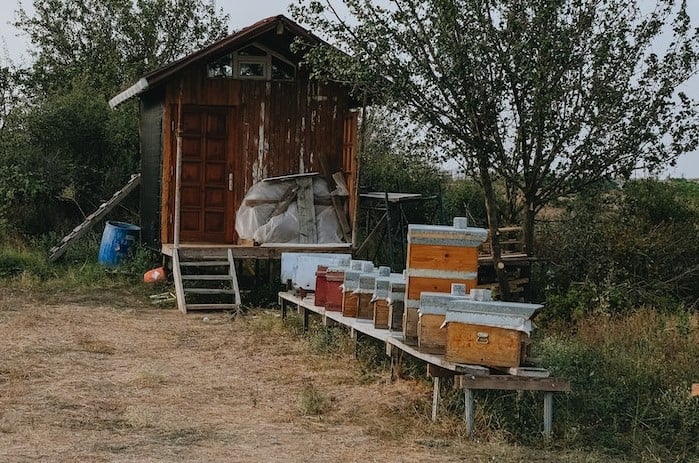
3 Questions to Consider Before You Start Beekeeping
1. Does Nature Fascinate You?
Do you notice a different colored blossom from the usual mix during springtime? Does the sight of a bird taking a bath make you pause? Do you have an interest in animal documentaries and such?
You don’t need to be an environmental activist, but you will need to learn about the environment your bees will be living in to ensure that they are healthy.
2. Do you like the outdoors?
You don’t have to be a mountain climber. I most certainly am not. However, beekeeping is primarily an outdoor activity, and even when you’re not inspecting the hive or harvest, you will need to observe your bees as they go about their business.
That little spy kit that you got on your 12th birthday isn’t going to cut it. You will need to watch their movements around the entrance of the hive because if there’s cause for alarm, your first clue will probably be outside.
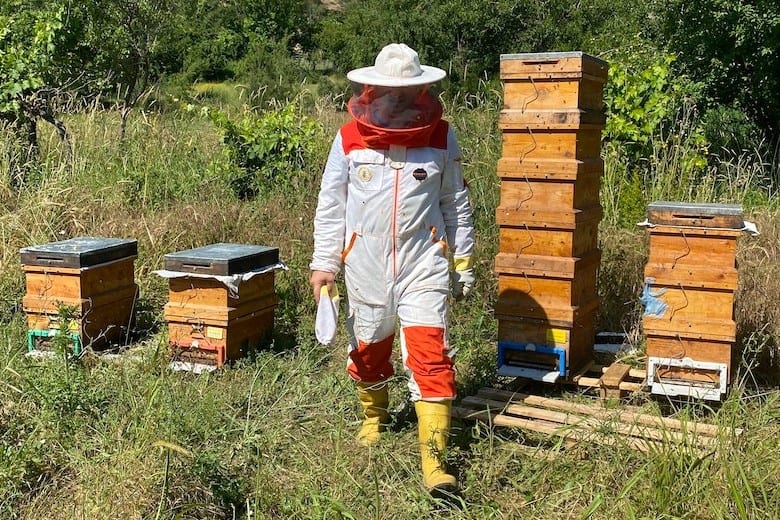
3. Are you allergic to bee stings?
Unless you’re an adrenaline junkie, bee-keeping as a “life or death” situation would not be much fun. When most of us get stung, and you will, swelling around the sting, some redness, and itching is usual.
If the rest of your body breaks out in hives, sweating, breathing difficulties, and such, that isn’t. If you’re unsure, visit a doctor first. With a blood sample, they can find out one way or the other and advise you accordingly.
And that’s it. Everything else you need to know about beekeeping you’ll learn on the job.
Fundamental Facts You Should Know Before You Start Beekeeping
If you are just starting out in the beekeeping world, then the amount of beekeeping knowledge that you’ll come across labeled “FAQs” can be a little overwhelming and surprise you. In this section, I hope to make things a little simpler.
The “how-to” section of beekeeping has so many variables that you rarely get a straight answer about. These include, for instance, what type of bee hive to get, where to purchase bees, what kind of bees to get, where to get your equipment, and so on.
What doesn’t change is the science behind the beekeeping basics and the functioning of the honey bees. So, let me break it down for you.
Bee Hierarchy
When you get your first colony, your honey bees will be comprised of a female mother, known as the queen, and a few thousand daughters, known as workers.
Later, if she and the rest of the colony are in good health, she’ll have a few sons. These male bees are called drones.
These drones don’t contribute to your bee colonies at all. Instead, they are there for the bigger picture, that is, the continuity of the bee species.
The Queen
Your two greatest concerns are the queen and the workers. The queen mates once but with several drones. She then stores the sperm and returns to the hive to take up the only role she will play for the rest of her life, populating the colony.
Her Majesty can only be dethroned by a younger queen or by death. Demotion is not an option. A good queen can live between 3-5 years.
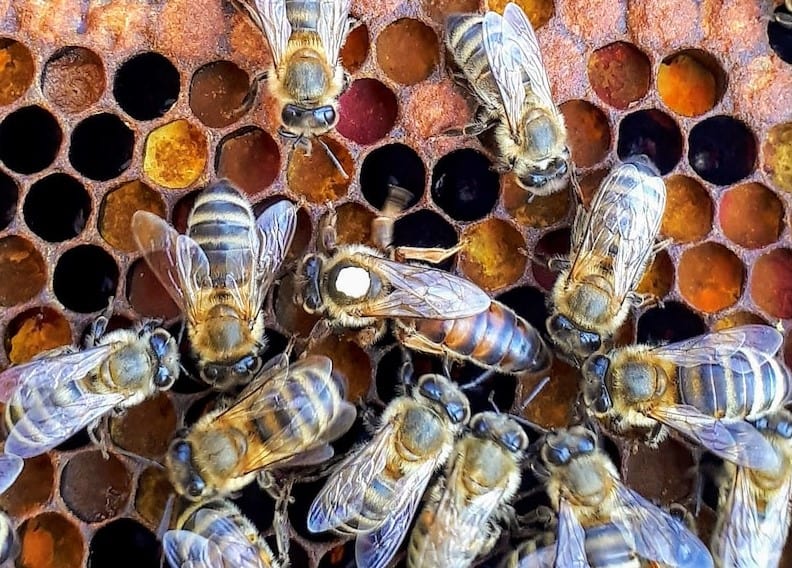
The Workers
The worker bees are the workforce of the colony and actually the masterminds behind the queen’s authority. They decide when she has to go. They also decide what kind of eggs she should lay.
The worker bees clean up and bring home the bacon, which in their case are pollen, nectar, and water. They also raise the young and defend the hive to death.
A change in their behavior or their bodies is usually the first sign of a problem. These little guys literally work themselves to death and live about 6 weeks when they’re busy and more than double that during the winter season.
The Drones
The drones only become a problem if they are missing altogether or if they constitute more than one-fifth of the population. Then, when times get hard and nectar and pollen are in low supply, the poor guys are pushed out of the hive, usually to fend for themselves and eventually die.
It’s a perfect example of the “if you don’t work, you don’t eat” philosophy in practice. These bees can’t sting. They don’t forage. They simply eat, mate, and die.
What Bees Eat
They need pollen for protein, nectar for energy, honey when there’s no nectar, and water to help with the production of royal jelly, cooling the hive, and, just like us, survival.
It would be a good idea to identify the dining options for your bees before you get them. Since they can travel 3 miles away for a good food source, be a little proactive. Find out what your neighbors are growing and how bee-friendly the trees and plants are.
Even though providing sugar syrup, among other supplements, has become common practice in bee-keeping, it’s always better if they can rely on their honey stores to get them through the winter.
You can also plant a few nectar-rich trees and flowers in the space available to you to boost their production when our flowers are in bloom.
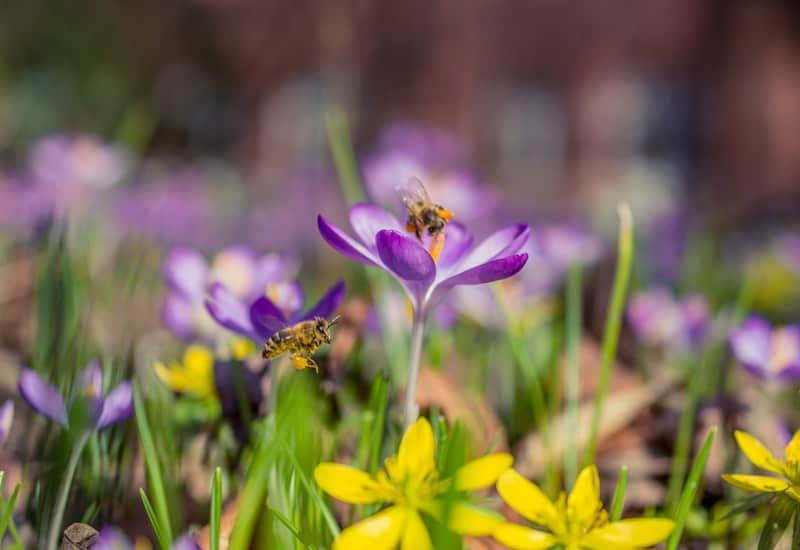
Conditions That Are Necessary for Bees to Thrive
The answer here is in nature. In the wild, you will usually find a colony making its home in the hollow of a tree. Think of this as a wooden cabin.
It keeps you cool when it’s hot outside. It’s warm and cozy when the temperature outside plummets. It keeps the winter wind from stealing whatever warmth you may have left.
That’s probably why most of the beehives like this one are made of wood.
They are also cold-blooded and keep activity at a minimum during the cold season. And that’s why having your colony make it through the winter is such a big deal.
If they don’t have enough honey stores or are unable to access their pantry, they starve. If they don’t have a good enough number to form a sizeable cluster for warmth, they freeze.
You will find that most beekeepers will take away certain sections of the hive in preparation for the winter.
If you’re in a large auditorium, with only a handful of people, it’s likely to be much colder than if you were in a small living room with the same number of people.
What You Need to Know about Getting Stung as a New Beekeeper

The individual bee gains nothing by stinging anyone. It dies, so it doesn’t get a do-over if it stings your shoe or your eye.
As with most critters that harm us without the ability to devour us, it only happens when they feel threatened. Whether you intentionally threatened the creature is irrelevant.
The great thing about bees is that they have that buzz, which you can equate to the rattlesnake’s rattle. If you’re out and about on a warm day and you pass anywhere near a hive, you’ll hear them.
Your options? Leave quickly. Unless you’re dressed for the job, do not linger around a hive because you’re curious.
That’s why we have documentaries and animal planet. Once you’ve learned how to handle bees appropriately, then you can approach them. But always remember that as long as they feel threatened, they are likely to sting.
Bees aren’t the only Striped Stinging Insects
Members of the wasp family boast a lovely yellow and black exterior, but they are nothing like our smaller, lovely tenants.
Unlike bees, they don’t leave a piece of themselves when they sting you, so they can do it again and again and again.
Therefore, some of the complaints you may hear from non-beekeepers are a case of mistaken identity.

Why Bees Are in Danger
They sound pretty self-sufficient. Why is there so much hype about them being in danger?
Well, we’ve taken away a significant portion of their food source to erect buildings. What food we do grow, we coat in insecticides, which are designed specifically to kill insects, which bees are.
Then we got a little too ambitious and started moving colonies across oceans and bringing with them vermin that our bees were not built to fight.
So, if they don’t starve, they get poisoned. If they survive that, they are plagued by mites and bacterial infections. This is the ugly truth about the world we live in.
But it’s not all bad news. Now that people realize that there’s a problem, you and I can help recover their lost glory.
Farmers who have recognized the vital service they receive from bees are very careful about the chemicals they use and how they use them in order to minimize the impact on colonies.
And as it turns out, if it’s good for the bee, it’s good for us beings.
What Bees Give Us
What do bees give us? We all know about honey, but there’s a long list of bee products.
Bee pollen like this which is the pollen that bees use as their source of protein, we use as a dietary supplement.
There’s propolis, which has great antibacterial properties and is the black stuff you’ll see inside the hive. There’s royal jelly used in alternative medicine to treat ailments such as arthritis.
And there’s also the beeswax that’s great for cosmetics as well as making aromatic candles. Bee venom is gaining popularity in the medical field and has recently joined the list of bee products as well. So, from a business perspective, there’s a whole range of products that you can specialize in.
Of course, pollination services are not to be left behind. Almonds are 100% pollinated, and who do you think they call on for this service? A very special six-legged delivery agent without whom they couldn’t do without.
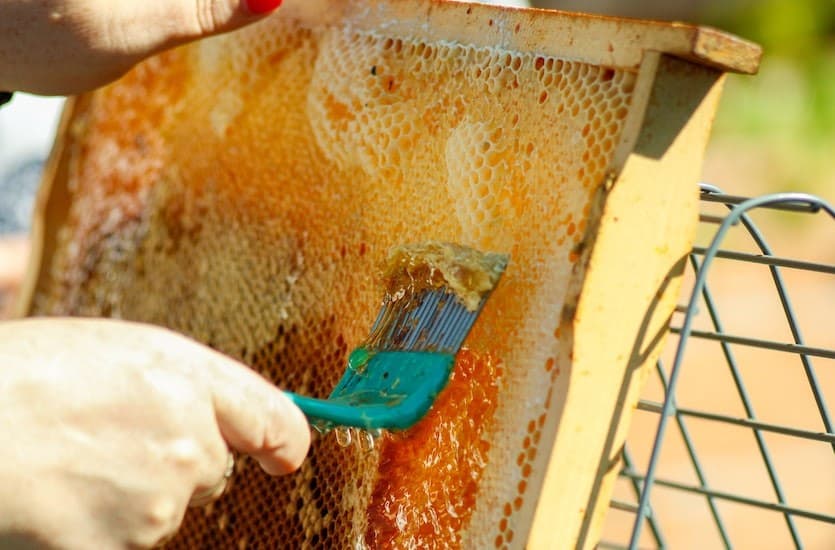
How to Successfully Start Beekeeping As a Brand New Beginner (Step by Step)
Now that you know the basic science of the bee, how the heck do you begin to keep and care for them? I’ve broken down the process of becoming a beginning beekeeper into five steps.
Step 1 To Start Beekeeping As A Beginner: Stock Up On Knowledge
If you’re a new beekeeper who is just starting out, then the amount of information at your disposal is incredible. It just so happens that beekeepers, as a group, can’t help themselves when it comes to sharing information.
They are always eager to share their war stories, what has worked, and definitely what hasn’t. Therefore, your first stop should be your local beekeeper’s association.
Join Your Local Beekeeping Association
Meet local beekeepers. Why local? Well, as I said, I didn’t do much research when I started my first beekeeping season. What I did have to go on was a marketing pitch that was based in a completely different part of the country.
The local climate and weather patterns are much cooler where my apiary is, so naturally, the productivity levels are quite different. I also tried to grow the same flowering plants as they do in warmer areas. Disaster!
Save yourself the heartache and start with what appears to be working within your zone. It would help if you could join a local beekeeper on a few hive inspection visits.
Familiarize yourself with the lingo, the equipment, and, most importantly, the bees. During the nectar season, you’ll be dealing with tens of thousands of bees.
The first time you do it, it can be quite intimidating, so you’re better off in the company of someone with way more experience as you learn beekeeping at home.
In some cases, local beekeepers may hold a beekeeping class from time to time. You wouldn’t want to miss that one, right?
Read Books and Watch Videos

Beekeeping education requires that you read. Living in the age of YouTube is both a blessing and a curse. Sometimes, you watch a video called “How to harvest honey,” and all you see are hands and honeycombs.
Many don’t go into detail about harvesting honey, how they knew it was time to harvest, how long it took, what blooms are about, the difference in the color of the honey, etc.
You see a comb; it looks white on top, which means that it must be honey. And yet, brood, which is what we call the egg, larvae, and pupa, is also capped.
The advantage of having good literature to get you started is that these beekeeping books give you a context for the information you’re seeking. What’s cool about it is that there’s always something new to learn and therefore try.
So, never tire of doing bee research. You probably won’t because, as I said before, it can be very addictive.
Be Familiar with Your Local Zoning Laws
The other thing you need to know about is the zoning laws in your area. In some places, they won’t let you keep your bees.
Unfortunately, if you don’t proactively seek out this information, some president of the wasp association will come knocking and tell you, oh so politely, that you are in violation of code 3 subsection k and you have 48 hours to get rid of the dead insects before you’re slapped with a fine.
In the event that you live in a zone that prohibits bees, don’t lose hope. There’s nothing stopping you from making friends with other beekeepers who don’t live too far away and negotiating a little space for you to get started.
With time, who knows, the law could be changed. But in the meantime, why not gain some experience?
Step 2 To Start Beekeeping: Get Your Equipment
What do you need to start beekeeping? First, let’s be clear. Just because the marketing pitch sounds good doesn’t mean you need to get it.
In some parts of the world, a starter kit includes ten bee hives, an extractor, two bee suits, and the usual beekeeping equipment, such as a smoker, a hive tool, and a bee brush. They also have some uncapping forks and a day of training.

It sounds like a great deal, but it really isn’t. You don’t need most of that stuff, and that day’s training, once you start beekeeping, will not have begun to scratch the surface. Ideally, what you want is what you can’t possibly do without.
Beehives
First, let’s talk about the types of hives available to beekeepers. I would suggest you start with two. Remember, you’re learning how to keep bees, so you need to spread your risk a little. Having just one is having all your eggs in one very delicate basket.
Second, you can try out some of the suggestions that you think are good, but have a control group just in case things don’t go as they should.
The space you need for two isn’t really that much more than you need for one. The maintenance needs for the two are very similar and won’t take that much more time.
Although new is always safer, bees don’t really care about the new hive smell as we do about the new car smell. They actually like a hive that had previously had owners. Perhaps it’s like a proof of concept. If the bees before us made it, then so shall we.
The only problem is ending up with a hive whose previous occupants were diseased. It’s worth mentioning that some of those bacteria can virtually live forever.
So, if you have a trusted beekeeper, and you can get the equipment tested or treated, then, by all means, get the second-hand equipment.
The bees will love it, and it’s easy on the pocket. But the keyword here is TRUSTED. That title is earned, so do your homework first.
For your backyard setup, what you’ll need is two hives, something to keep the hives off the ground, which could be a stand or even cinderblocks. The idea is to keep your hive stable but away from critters and possible flooding.
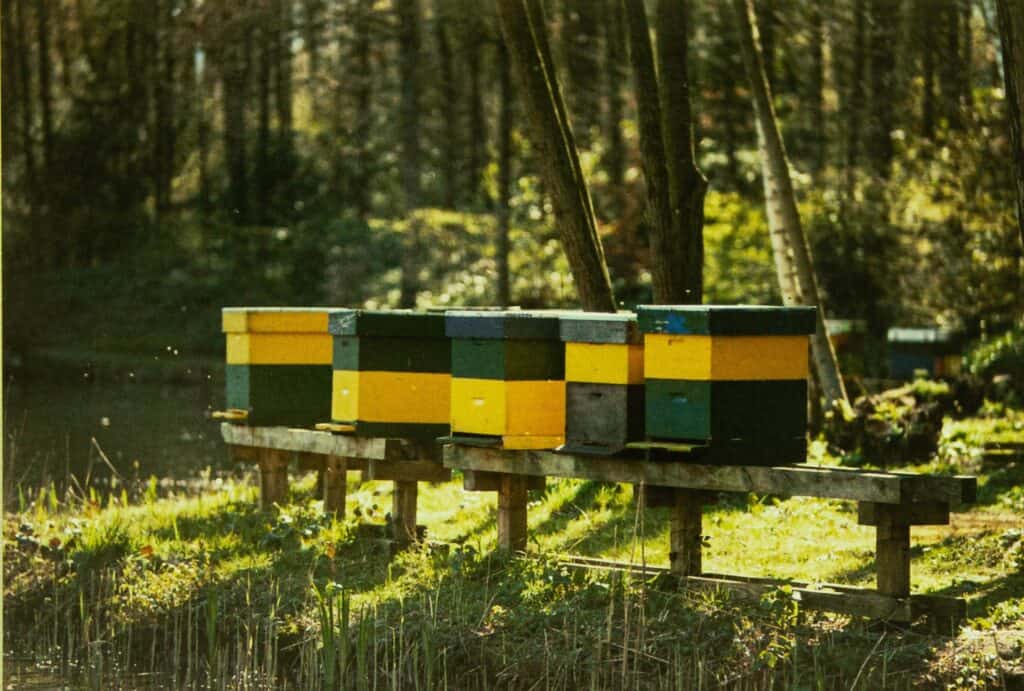
Suit and Gloves
To protect yourself, you’ll need a full bee suit with a veil and gloves. You’ll come across videos of people with just a shirt and pants, but they’ve been doing this a lot longer than you have, so first, start with a suit.
The prospect of being stung in the face is daunting and, therefore, distracting. You’ll graduate to that hardcore status soon enough.
Tools of the Trade
Then, the tools of the trade, which are the smoker, a good hive tool like this, and bee brush. These you will need every time you want to take a peek inside the hive. In fact, for many seasoned beekeepers, the suit is optional; the smoker never is.
There are a bunch of other things that you will eventually use, like a bee escape board or uncapping forks, but you won’t need those when you start.
However, the best place to get this information is from a local beekeeper or from the beekeepers’ association near you.
Step 3 To Start Beekeeping: Get The Bees
That’s why we got into the game in the first place.
Choosing bees is like choosing a family dog. You don’t get a Great Dane if you live in a studio apartment.
You need to find one that suits not just your preference but the environment it will be living in.
Each variety has its pros and cons, so you need to prioritize what your biggest concern is. However, it’s never too early to learn about your options. So, let’s meet our contestants:
Italians (Apis mellifera ligustica) –
Italian Bees are the bee equivalent of the person voted to be the “most likely to succeed” in high school. They are pretty mild-mannered and are great at populating the hive, which makes them great at honey production.
They are great for beginners and commercial beekeepers whose goal is honey production. The chink in their armor is that they have big appetites to go with all that productivity.
They are notoriously known for robbing weaker colonies and wiping out your honey if you don’t get it out of the hive in time. This robbing behavior means that they can spread diseases faster in an apiary.
Because of their great number, they can starve if they don’t have enough honey stored for the winter. They are also susceptible to varroa mites, so they will need a little TLC and keen observation.
In summary, great temperament, great at multiplying the workforce, wonderful honey producers, but they have a little kleptomania to satisfy their big appetites.

Carniolan (Apis mellifera canica)
The Carniolan Bees would be the runner-up in popularity. They are gentler than the Italians, not known to rob other hives as much as the Italians, and really build up numbers quickly.
They are also better at foraging in cooler weather and generally better at surviving winters.
The downside is that these bees swarm very easily. Swarming is where the old queen is relieved of her duties and takes a few thousand bees with her to create a new colony.
That brings down honey production and can be a nuisance to your neighbors because you have little control over where they end up.
In summary, very mild-tempered, so if you have pets and kids around, these would be great. Very high survival rate over winter and fantastic pollinators, so great for the strawberries you have in the garden.
Caucasian (Apis mellifera caucasica)
This is the teddy bear of the bee races. It’s a very gentle bee and is very similar to the Carniolan variety, with two exceptions. Their baby boom is a little slower than the Italian variety, and therefore, there are those who find them to be less profitable in the honey arena.
That said, they make great pollinators because they have very long tongues that allow them to get nectar from flowers that other bees can’t access.
They also have a habit of coating everything in propolis, which is great if that’s the product you want to deal with but challenging to work with because this substance tends to glue the movable parts of the hive together. Talk about a sticky situation.
In summary, gentle insects, great pollinators, great overwintering capabilities, low feeding requirements, but you’ll need a lot of elbow grease to get through the propolis layers.
Russian Bee
The origin is right in its name, so you can guess that it does well in cold frosty areas with high winter survival rates. That’s just the bonus benefit. It was imported by the US Department of Agriculture for its resistance to the mighty varroa mite.
This pest has devastating effects on colonies and is one of the reasons why the bee population is in danger. The program was very successful, and after the initial study period, colonies were made available to apiarists.
But when you get the horse, you have to deal with the manure. These bees are not as mild-mannered as the Italians or Carniolans, and they have unpredictable swarming patterns.
To add to that oddity, they always have queen cells waiting, which is probably why the swarming patterns are so unpredictable.
Finally, their mite-resistant gene is easily watered down if you have a different bee race within mating distance. So once you go Russian, you stay Russian.
In summary, Russian bees have been found to be resistant to the varroa mite and, in some cases, even the tracheal mite. They aren’t as friendly as the first three. Their population is controlled by nectar availability. Therefore, when the flowers bloom, and there is abundant nectar flow, be proactive; otherwise, you may have swarming.
Bottom Line When Choosing Your First Bees as a New Beekeeper

In truth, you’re likely to wind up with a mutt race, which is a blend of everything and nothing in particular.
All that matters is you get bees that are docile and easy to work with. That’s what many beekeepers have, so you’ll be in good company.
Order bees early. Don’t wait for spring to start making calls. It may be too late by then.
Use the time in between order and delivery to make sure everything is set up for your special guests.
Step 4 To Start Beekeeping: Dive Right In And Get Started
Once your bees arrive, you need to install them into the hive. This has to be done with great care because you don’t want them to reject the hive, which we in the business call absconding. Different beekeepers will have different methods of doing this, but there is a trick to whatever method.
Bees, like people, are much easier to deal with when they’re well-fed. They are less likely to fly around and prefer to crawl along a given surface.
So, before you begin, give them a healthy dose of sugar syrup. Once they have had their fill, then you can proceed to move them from the package they come into your hive.
The first time you do this, it’s best to have the company of an experienced beekeeper. That way, you ensure that you have as few bee fatalities as possible.
Step 5 To Getting Started: Enjoy The Fruits Of Your Labor.
I’m not going to lie; it will be a long wait before you can boast about your all-American homegrown self-branded jar of honey. One bee, in its six-week lifetime, will make a twelfth of a teaspoon of honey.
So, let’s do some basic math. Given a good queen and a good supply of nectar, you could get between 100 to 200 pounds per year per hive. But this is the best-case scenario, which is rarely achieved.
The average bee-keeper gets about 50 pounds, but it varies depending on where you are in the country and what nectar sources are available to your bees.
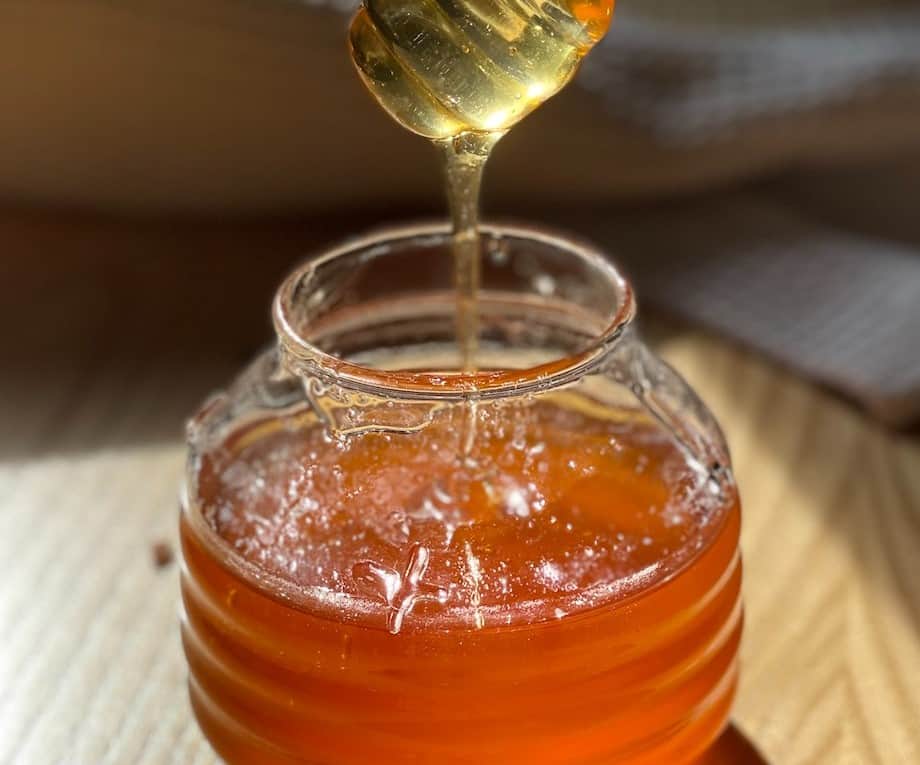
Final Thoughts on How to Start Beekeeping at Home
Hopefully, by now, you have a better understanding of how to get started as a beekeeper, why you should start keeping bees, and how they can positively impact your life.
Here’s the bottom line, though: in order to get the most from your six-legged tenants, their comfort is your priority.
They are the ball you need to keep your eye on. If you want to hit a home run and get good amounts of honey, your bees need to be healthy, happy, and comfortable.
To enjoy beekeeping as a “newbee”, you’ll need to become a novice entomologist with a dash of botanical knowledge and a bucket load of good humor.
You will find that many beekeepers are happy to share their trade secrets, and why wouldn’t they?
They are constantly seeking to support each other because when things start to go wrong for your neighbor, there’s a high chance that misfortune may befall you because you have almost no control over the comings and goings of your bees.
Welcome to the family, and let the fun begin.

This beginner’s guide to beekeeping offers valuable insights and practical advice for those interested in starting this rewarding hobby. The author’s personal journey from initial misconceptions to a deep passion for beekeeping adds a relatable touch. The article effectively highlights key considerations, such as the importance of local knowledge, equipment requirements, and understanding bee behavior. It emphasizes safety and responsible beekeeping while providing a glimpse into the fascinating world of these essential pollinators. This comprehensive guide serves as a valuable resource for anyone looking to embark on a beekeeping adventure.
Excellent Article : >). I will be attending a Beekeeping class with the San Francisco Beekeeper’s Association tomorrow, March 2, 2024. I have already read many articles, watched YouTube videos, etc. but your summary of the best breeds to consider, their traits and behavior etc. I found very useful. So Much To Learn !! : >) Tnx . . PL